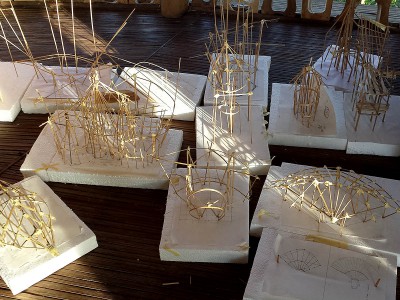Attended a workshop on bamboo building and design in Bali in the “Green Camp”. Utilising a multitude of various bamboo species, it is possible to build very cheap houses, either for temporary shelter or for more lasting houses for poor people. The Green Camp people have also designed very fancy and even luxury bamboo houses. They look beautiful, but some designs annihilate the ecological advantage of the bamboo by wasting energy. For example there is air conditioning in some of the houses, which definitely doesn’t make sense in an open building.
Anyway, the workshop was big fun, and bamboo is a great material, in particular in the climatic conditions of tropical countries.
Building – a male domain?
Unexpectedly, about half of the participants were women, in contrast to the common notion that men are in charge of building. In a number of powerpoint presentations, I found the quote “in a study of 224 cultures across the world, there were 5 in which men did all the cooking, and 36 in which women did all the house-building”. The source dates back to an anthropological study carried out in 1937 (George Peter Murdock “Comparative Data on the Division of Labor by Sex,” Social Forces, 15: 551–553). However, a closer look at the data reveals that the difference is not that large: in 86 of 224 traditional societies, men did all the house building, while for another very similar category of activities, namely erecting and dismantling shelter, women were in charge in a larger number of societies than men. Gender differentials for other activities were much larger, e.g. carrying water (guess who?) or making weapons (guess who?). In conclusion, it can be assumed that building houses is not necessarily a men’s domain. The gender dimension might be more evident in the design of houses which is likely to reflect gender relations and roles, see for instance Girija Shrestha: Gender Relations and Housing: A Cross-community Analysis. Gender Technology and Development March 2000 vol. 4 no. 1 61-86.








